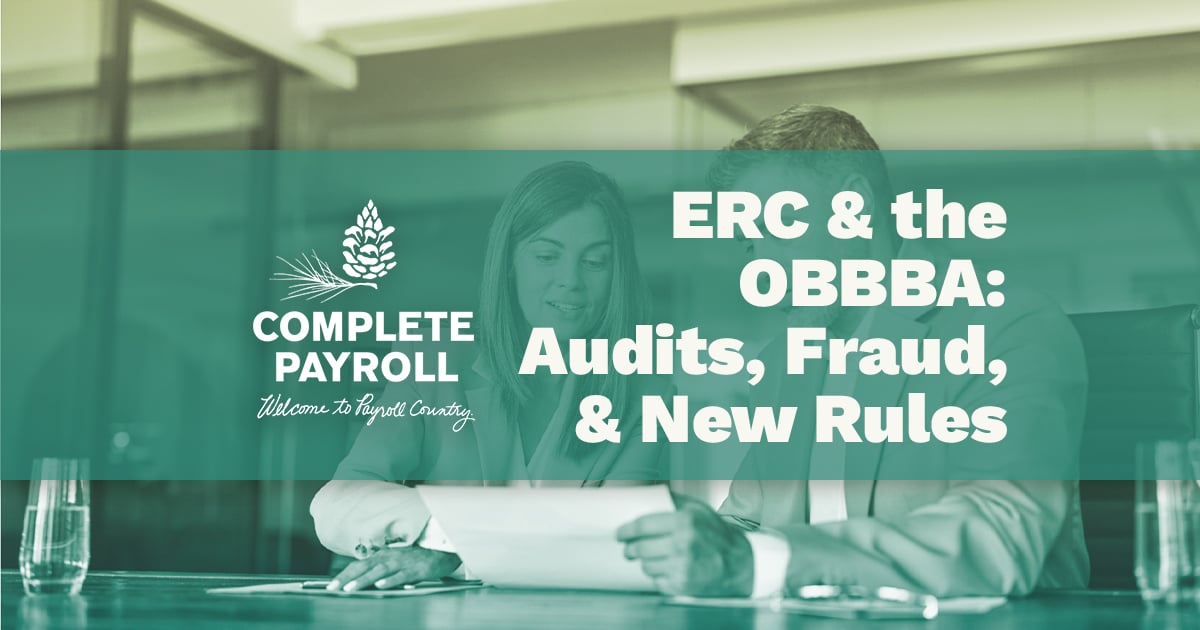Employee Retention Tax Credit and the American Rescue Plan Act
A detailed and straightforward guide for employers. This page will explain the ERC and help you navigate and maximize the tax credit for your business.
On March 11, President Biden signed into law the American Rescue Plan, which extended and expanded the Employee Retention Credit (ERC) that was originally part of the Consolidated Appropriations Act (a segment of the Coronavirus Aid, Relief, and Economic Security or CARES Act). Through this expansion, employers can claim credits for those employees they have retained during the COVID-19 pandemic.
The American Rescue Plan, or ARP for short, is the most recent piece of legislation aimed at COVID-19 related recovery here in the United States, following the Taxpayer Certainty and Disaster Tax Relief Act of 2020 (or Disaster Relief Act) and the Consolidated Authorizations Act that were enacted on December 27, 2020.
When it was enacted, the Disaster Relief Act made changes to the ERC to retroactively include recipients of the Paycheck Protection Program to be able to also claim the ERC for 2020 and expanded the ERC for 2021. Now, the ARP is building on these laws to make it even more appealing for employers to take advantage of this tax credit.
Additionally, the ARP gives employers until December 31, 2021, to claim their tax credit—an extension of 6 months compared to the previous deadline that was set by the Consolidation Authorizations Act.
Contents
- About the Employee Retention Credit
- Following the Progression of the ERC
- Which Employers are Eligible for Employee Retention Credit?
- What Wages are “Qualified Wages” that are Eligible for ERC?
- How Do the Credits Work?
- About Retroactively Claiming an Employee Retention Tax Credit
- Navigating the Employee Retention Tax Credit
About the Employee Retention Credit
What does the Employee Retention Credit entail? According to the IRS, the ERC is a refundable tax credit against some employment taxes that are equal to 50 percent of the qualified wages eligible employers pay to their employees after March 12, 2020. The IRS has made these credits immediately available by reducing the total amount of employment tax deposits employers must make.
Businesses can claim these refundable credits based on certain qualified wages including health plan costs.
The ERC gives employers a refundable payroll tax credit who fall into one of two situations:
- Employers whose operations were either fully or partially suspended as a direct result of government orders.
- Employers who saw a quarterly decline in gross receipts compared to the same quarter in 2019.
For the second scenario, employers need to have noted one of two occurrences:
- A 50 percent quarterly decline to qualify for the 2020 ERC
- A 20 percent quarterly decline to qualify for the 2021 ERC
Additionally, the nature, amount, and availability of these credits will vary based on the year, since the 2020 ERC is different from the 2021 ERC.
Following the Progression of the ERC
The Employee Retention Tax Credit first showed up as part of the CARES Act but has since been part of the Consolidated Appropriations Act and the American Rescue Plan Act. Here’s what you need to know about each.
CARES Act
Under the CARES Act, the ERC was designed to encourage businesses to keep their employees on payroll by offering a refundable tax credit of up to 50 percent of as much as $10,000 in wages per employee for wages paid between March 13 and December 31, 2020.
The Consolidated Appropriations Act and Disaster Relief Act
The ERC benefits and provisions under the CARES Act were set to expire at the end of 2020 and so Congress enacted the Disaster Relief Act. Through this legislation, the ERC was extended to include wages paid during the first two quarters of 2021—between January 1, 2021, and June 30, with the following changes:
- Employee retention credits were raised to credit up to 70 percent of qualified wages.
- Eligible wages were expanded up to $10,000 per quarter instead of $10,000 total paid to an employee. This means that the maximum ERC amount available for the first two quarters of 2021 is $14,000 total per employee or $7,000 per quarter.
American Rescue Plan Act
The American Rescue Plan continued the ERC provisions as outlined in the Disaster Relief Act through the end of 2021. Qualifying employers who continue to qualify for all four quarters of 2021 can receive up to $28,000 in ERC per employee, which is 70 percent of the $10,000 quarterly wage cap times four quarters. The ARP also created two additional classes of businesses that can qualify for the ERC:
-
Recovery Startup Businesses (RSBs):
RSBs are employers who began work after February 15, 2020, and gross less than $1 million in receipt annually, and do not meet the partial shutdown or significant revenue drop qualifications. RSBs can now claim 70 percent of wages paid each quarter per employee for up to $10,000, with a total quarterly cap of $50,000. -
Severely Financially Distressed Employers:
These are employers whose gross receipts in the third and/or fourth quarters of 2021 amount to no more than 10 percent of their gross receipts from the same quarter in 2019. Severely financially distressed employers can treat all wages paid to employees during the applicable quarters as qualified wages, even if they had over 500 employees in 2019.
Which Employers are Eligible for Employee Retention Credit?
The good news is that most employers can qualify for the ERC under the American Rescue Plan Act. Where businesses who took out a loan under the Paycheck Protection Program (PPP) were ineligible to claim the tax credit, many more employers are eligible, including colleges, universities, hospitals, and 501(c) organizations.
The ERC can be confusing for businesses and their employers—after all, while the phrase “unprecedented times” has been overused since the onset of the pandemic, this kind of tax credit is truly unprecedented. There are two ways that employers can qualify for ERC, and employers only need to meet one of these two criteria to qualify:
- Financial Losses: If a business can show a significant drop of over 50 percent in quarterly revenue from one quarter in 2019 compared to the same quarter in 2020. For 2021 ERC, the quarterly revenue dip only needs to be 20 percent compared to the same quarter in 2019.
- Government Shutdown: Businesses that were directly or indirectly affected by a government shutdown. This is clear for restaurant owners, hotels, theatres, and gyms, but other offices may qualify as well, such as dental offices, manufacturers, or nonprofits. These kinds of organizations can help determine their responsibility through diagnostic questions like:
- Did a shutdown affect your ability to travel or hold group meetings for work?
- Was your supply chain affected?
- Was your business negatively affected by having to operate under reduced capacity?
- Did you have to suspend or pause your operations to disinfect your place of work?
At least one of the factors must apply for the quarter in which you plan to utilize the tax credit. One important note to keep in mind?
An organization that was either fully or partially suspended or was required to reduce business hours to comply with a government order is eligible for a tax credit that applies for only the portion of the quarter that operations were suspended.
The IRS Notice 2020-21 gives some additional guidance to help figure out if a business qualifies for ERC based on a full or partial shutdown:
- Can employees telework or work remotely?
- Is the work portable?
- Must employees be physically present to do their work?
- Did telework require a transition period?
All private-sector businesses and tax-exempt organizations that conduct a trade or business can be considered, but most government employers are not eligible. Essential businesses can qualify, and the number of employees a company has does not impact the ability of the employer to claim a credit.
CARES Act
If gross receipts from a particular calendar quarter in 2020 are less than 50 percent of the gross receipts for the same calendar quarter in 2019, an employer is eligible for the ERC. However, an employer is no longer eligible if the next quarter their gross receipts are higher than 80 percent of the same calendar quarter from 2019.
Consolidated Appropriations Act
Businesses that were forced to close or quarantine and have experienced a drop in gross receipts of 20 percent or more compared to the same quarter in 2019 are eligible. New businesses may use the receipts from the quarter they started operations.
American Rescue Plan Act
This act gives businesses the option for eligibility based on their gross receipts from the immediately preceding quarter.
To claim the ERC benefits, eligible employers should report their total qualified wages and related health insurance costs per quarter on their quarterly employment tax returns. For most employers, this information should be reported via Form 941. This credit will be taken against the employer’s share of Social Security tax.
Employers can retain a certain amount of their employment taxes in anticipation of claiming the credit up to the amount of the credit without any kind of penalty. This includes:
- Federal income tax withholding
- Employees’ share of Social Security and Medicare taxes
- Employer’s share of Social Security and Medicare taxes
To uncover more about eligibility for the Employer Retention Credit, watch our in-depth interview with Scott DeLuca LLP below. See how to make full use of the American Rescue Plan.
What Wages are “Qualified Wages” that are Eligible for ERC?
When it comes to the ERC, the definition of “qualified wages” is dependent on the number of employees an eligible employer has. With each new bill passed, these stipulations have changed. As of January 1, 2021, the definition of qualified wages was altered to provide the following:
Employers with More Than 500 Full-Time Employees
Per the IRS, for those who averaged over 500 full-time employees during 2019, the term qualified wages generally refers to wages paid to employees that are not providing services because operations have been fully or partially suspended or were related to the decline in gross receipts. This includes certain healthcare costs and includes as much as $10,000 per employee.
Employers can only count wages up to the amount the employee would have been paid for working an equivalent amount of time during the 30 days prior to the period of economic hardship.
Employers with 500 or Fewer Full-Time Employees
For employers who averaged 500 or fewer full-time employees in 2019, qualified wages generally count as the wages paid to any employee during the time that operations were fully or partially suspended or during the decline in gross receipts, whether or not employees are providing services. This also includes healthcare costs.
Who Qualifies as a Full-Time Employee?
For the purposes of the ERC, the IRS states that full-time employees who worked at least 30 hours per week or 130 hours in any calendar month in 2019—the monthly equivalent of 30 hours per week.
For employers who were in business throughout the entire calendar year in 2019 or 2020, they can figure this total by adding the total number of full-time employees each month of that calendar year and dividing that sum by 12 to arrive at the average number of full-time employees for that year. Those who started a business in 2019, 2020, or 2021 should do the same, then divide by the total number of months they were in operation.
It is important to note that this is different from determining the full-time equivalent for the PPP forgiveness report.
About Qualified Health Expenses
Perhaps the biggest question that remains for many organizations is regarding what constitutes “qualified health expenses.” As it stands, the American Rescue Plan amended and extended the tax credits and the availability of advance tax credit payments to include paid sick and family leave for wages through September 30, 2021.
The term qualified health plan expenses refers to the amount paid by eligible employers to provide and maintain a group health plan to the extent excluded from the gross income of employees. The amount of qualified health plan expenses used to determine the credits includes:
- The portion of the cost paid by the eligible employer
- The portion of the cost paid by the employee with pre-tax salary reduction contributions
While both contributions are included here, the qualified health plan expenses included in the ERC do not include any amount paid by employees with after-tax contributions.
How Do the Credits Work?
Per the American Rescue Plan Act, non-refundable portions of the employee retention tax credit will be claimed against Medicare taxes for wages paid after June 30, 2021. Until this point, they will remain as claimed against Social Security taxes as in 2020.
If credits exceed an employer’s total liability of their portion of Social Security or Medicare (based on the date), the excess amount will be refunded to the employer. At the end of each quarter, the amount of these credits should be reconciled on an employer’s Form 941.
How Does an Employer Claim Their Credits?
To claim their ERC, eligible employers must report their total qualified leave wages, qualified health plan expenses, and their share of Medicare tax on qualified leave wages for each quarter on their federal employment tax return, Form 941.
Eligible employers are allowed to defer their deposit and payment of their share of Social Security tax under section 2302 of the CARES Act. Employers may also opt to defer their withholding and payment of the employee’s share of Social Security take on certain wages paid between September 1, 2020, and December 31, 2020.
In anticipation of claiming credits on Form 941, eligible employers are permitted to retain the federal employment taxes they otherwise would have paid, including:
- Federal income tax withheld from employees
- Employees’ share of Social Security and Medicare taxes
- Employer’s share of Social Security and Medicare taxes
Form 941 has more detailed instructions on how to reflect these reduced liabilities for the quarter.
About Retroactively Claiming an Employee Retention Tax Credit
There are all kinds of guidance available for claiming an Employee Retention Tax Credit, but only for qualified wages paid between March 13 and December 31, 2020. However, eligible employers who received PPP loans can also retroactively claim their ERC.
To do this, employers should file Form 941-X, Adjusted Employer’s Quarterly Federal Tax Return or Claim for Refund for all applicable quarters. This form is for employers and is used to correct errors on previously filed quarter federal tax returns.
The portion of wages that are eligible for these credits (especially for those who received PPP loans) will depend on how qualified wages were reflected on PPP loan forgiveness applications.
Navigating the Employee Retention Tax Credit
It can be challenging to know exactly how to claim your ERC, especially if you previously applied for, and were granted, a PPP loan. To learn more about the latest updates to the American Rescue Plan Act and the other credits and opportunities available to employers and small business owners during this time, consult some of our references here:
As always, Complete Payroll is here to be your payroll expert and help you navigate these challenging times. If you have questions or concerns about how your payroll is or should be affected by these new guidelines and opportunities, we are always here to help. Contact us today for additional guidance.
Arden Neubauer
My questions and concerns are addressed in a VERY timely manner and I never feel that I have to handle sticky issues alone.
Carol Grover
They have gone above and beyond. Complete Payroll is a trusted partner, a valued resource, and a respected adviser.
Cathie Rene
I was a novice to payroll so my learning curve was big. Andrea is wonderful helping me navigate payroll.
Cathy Pace
We were referred to Complete Payroll years ago by a board member and haven't looked back since. When I first started working with them, I knew nothing about payroll. My first rep Lacey, and now JoAnn, are great to work with. Working with Complete Payroll has just been a wonderful all-around experience for me.
Cathy Schuth
We very much appreciate the quick service. If I need a special report it arrives via email within one business day, if not that day.
Christina Wagar
Dr. Christopher Mozrall
Complete Payroll is a great payroll company, and we love Lacey! She always has the answers to my questions without hesitation. There is very little (if any) wait time to get a call back.
Colleen Koll
The first suggestion I made after I joined Shear Ego was that if they were not yet using Complete Payroll, they should be. We continue to be impressed and happy with the quality and friendliness of service, and the excellent newsletters and up-to-date information on all things payroll and HR.
Diane Romano
People do business with people, not with corporations. In over 20 years, we have only had two customer service reps. Instead of feeling like we are one of 10,000, CP makes us feel like family! We count on Lindsay getting it right, and she always does. Even when we go outside the box, all is as we expect it!
Recent Articles from the Blog
We're constantly publishing content about payroll, human resources or anything related to managing your people.
Subscribe to Our Newsletter
Twice a month we share relevant and timely blog articles and other resources. No solicitations. No funny business. Just quality stuff to help employers.


















